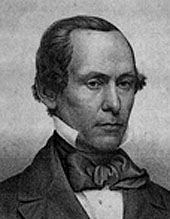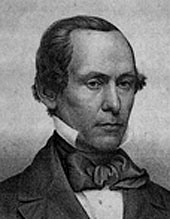
Ephraim Nute, Jr. (September 18, 1819-January 21, 1897), an outspoken and aggressive abolitionist, was the American Unitarian Association (AUA) missionary to the Kansas territory during the “Bleeding Kansas” years prior to the Civil War. A conductor on the Underground Railroad, he was a key figure in the free state cause. He lost family and friends to the violence there and had to fight to save his own life. His letters to New England provided information for Theodore Parker, Ralph Waldo Emerson, and many others who wrote and spoke against slavery. During the Civil War he served as a chaplain and a supervisor of soldiers’ homes.
Born in Boston, Massachusetts, Ephraim was the son of a Universalist merchant, Ephraim Nute, Sr. His mother, Mary A. Bancroft, died when Ephraim, Jr. was only a few years old. He and his family attended the Bullfinch Street church (then Universalist, later Unitarian). Eventually he served as Sunday school superintendent. He went to the Latin school in Boston and, on scholarship, attended Harvard Divinity School, 1842-45. He was a classmate of Joseph Henry Allen, John Pierpont Jr., George Frederic Ware, Samuel Longfellow, Frank Parker Appleton, William Orne White, Octavius Brooks Frothingham, and Thomas Wentworth Higginson. He married Lucy Ann Fessenden in 1841.
As a young man, Nute was attentive to how his soul would be accounted for to God. The young minister was upright to a fault, and stiff with New England Unitarianism—he was described as “pious” by a colleague. His regard for all his fellow human creatures bore the marks of his childhood religion, Universalism. As a result, early in his career he began to oppose slavery. Although most abolitionists, Theodore Parker among them, were not free of racism, Nute demonstrated his personal respect for the full humanity of both Native Americans and African Americans throughout his life.
Nute served congregations in Petersham, 1845-48; Scituate, 1848-51; and Chicopee, Massachusetts, 1851-55, before he accepted the AUA call to the mission post in Kansas in March, 1855. With

a revolver given to him by his colleagues, he departed for the West, arriving in Lawrence, Kansas, with a shipment of “Beecher’s Bibles”—Sharps repeating rifles which had been clandestinely bought by Boston Unitarians.
When Nute was installed as the Unitarian missionary to Kansas, he was given three charges by the AUA: to bring liberal Christianity to the West, to build the institutions of civilization—towns, schools, and churches—and to work to make Kansas a free state. Although successful in all three tasks, because the denomination was split over the slavery issue, Nute was ever frustrated at being ignored, denied, and underfunded in his mission.
The guerilla violence of “Bleeding Kansas” was underway when Nute arrived in Lawrence. He drew flocks to hear his open-air preaching on Mt. Oread, a promontory central to the town, and began to shape this early group of listeners into a Unitarian congregation. He raced to have the Unitarians be the first denomination to build a church there, hoping to make the voice of liberal Christianity important in the territory. Although the church building project was intermittently delayed by violence, weather, and sickness, it became a hub for free state, underground railroad, interfaith, and education activities. Nute’s efforts for the schools the church established eventually led to the founding, on Mt. Oread, of the University of Kansas. While still only a foundation, the church was used as a fort to repel pro-slavery forces. A number of church members lost their lives in these attacks.
By 1856 the undeclared civil war had taken many lives. Nute’s brother-in-law, William C. Hopps, was ambushed, murdered, and scalped. While trying to help his sister-in-law recover her husband’s body, Nute was captured and for a short time held prisoner. While he was missing, his friends in Boston and at Harvard expressed outrage and swore to recover his body, dead or alive. Nute later wrote to Theodore Parker criticizing the complicity of Federal troops in the murderous attacks of raiders from Missouri. He related that, to escape captivity and to return to Lawrence, he “mounted a Government horse, and rode amuck through the enemies going around 50 miles by unfrequented ways.” Parker read these letters to his congregation from the pulpit.
During the bleeding Kansas years Nute served on the Free State Legislature with John Brown, Jr. and became acquainted with his colleague’s father, the notorious abolitionist John Brown. He was in close correspondence with Samuel Gridley Howe, Franklin Sanborn, Theodore Parker, Thomas Wentworth Higginson, George Luther Stearns and Gerrit Smith, who were later revealed as sponsors of John Brown’s activities in Kansas, and the 1859 attack at Harper’s Ferry, West Virginia. Nute used his correspondence to pass information from Brown’s troops in Kansas to the backers in the East.
In 1859 the AUA, in order to relieve its financial problems, declared the Lawrence mission complete and drew its money out of the church. This so alienated Nute that after his missionary appointment expired in 1859—and he left amidst accolades to his character, courage, and success—he remained embittered by the AUA’s callousness towards the Kansas settlers and its inconstant support of the mission.
Nute left Lawrence abruptly. He is believed to have gone to Harper’s Ferry, West Virginia, to try to dissuade John Brown from attacking the armory. When Brown attacked the armory earlier than had been originally planned, Nute telegraphed the news to newspapers, then fled. Back in Boston, he joined the public outcry over the execution of Brown. Immediately afterwards, to avoid being investigated by the authorities over the Harper’s Ferry raid, he left for Europe and did not return until the furor had died down. While in Italy he visited Theodore Parker. After Parker died, he related his reminiscences of Parker from Parker’s own pulpit.
Nute returned to Lawrence in 1861. For a short time he made his living by giving lectures and was supported by a small sundries business run by his wife. At the outbreak of the Civil War, he joined the First Kansas Regiment as chaplain. He was soon detached from his regiment to work for the Western Sanitary Commission. This agency, largely run by Unitarians, provided field hospitals and respite homes for Union soldiers. Letters reveal that, while working for the Commission, Nute ran guns to Union soldiers behind the lines, and aided escaped slaves traveling to the North. In 1864 he mustered out at Fort Leavenworth, Kansas.
In Kansas, Nute’s theology took a distinctly liberal turn as he confronted having to take up arms in order to save his own life, and the lives of his family and friends. His constant confrontation with assaults on his own life, violent death, and the dying in Kansas and during the Civil War had a deep impact on his religious beliefs. These experiences broke down the stiff piety of his youth and brought him to express a more liberal Christianity.
In the years after the Civil War, although he preached as a guest in many different pulpits and in 1865 briefly served as an interim pastor at the Petersham church, Nute did not seek or accept a call to a Unitarian congregation. Instead he worked as an editor and writer for newspapers and magazines, and began to publish translations from French and Italian, including a version of Dante’s Inferno, ca. 1885.
In 1873 Nute obtained a divorce from his wife, Lucy, on the grounds of abandonment, when she refused to accompany him on his travels as a newspaper correspondent. Adelia Skinner, whom he married soon after, was a distant cousin of John Brown. The Nutes moved to Oberlin and Cleveland, Ohio and had two children, Mary and Thomas, in 1874 and 1876. By 1880, this new marriage had dissolved. Nute took his daughter Mary back to the East. He told her that her mother had died. Adelia had remained in Ohio with Tommie. In 1886 her sister committed her to an insane asylum. She is believed to have died there. Tommie was sent to an orphan asylum by his aunt and was not reunited with his father until five years later.
Nute married yet again in 1881, to widow Catherine Ann Coffin Anderson, who brought two stepsons, Melvin and Charles Anderson, to the marriage. The couple had two children, Ephraim, born in 1882, and Della, born in 1885 and who died of meningitis six months later. Although he and Catherine did not divorce, they were living apart by the late l880s. Nute then lived with his daughter Mary, and was later joined by his son Tommie. Still active in literary pursuits, he was a consultant to Richard J. Hinton in the book John Brown and His Men, and labored at a memoir about his experience in Kansas and in the Civil War.
In early 1897, after an accident with a horse, Nute was taken to Rhode Island Hospital with gangrene in his leg. After being denied amputation because of his age, he died of infection. His funeral took place at the Roxbury Universalist church, with James deNormandie preaching and Edward Everett Hale speaking. His ashes were scattered in the Rose Garden of the Forest Hills Cemetery in Boston.
When he died Nute had finished his lengthy memoir of Kansas and the Civil War. He had secured a publisher and his friend Edward Everett Hale had agreed to write the introduction. This manuscript, however, was lost by his children after his death.
The documents used in the preparation of this article are collected in Bobbie Groth and William C. Groth, Jr., What One Man Can Do For Freedom: The Life of Rev. Ephraim Nute, Jr. (2007). Nute’s letters may be found in the American Antiquarian Society, Boston, Massachusetts; the Andover-Harvard Theological Library, Cambridge, Massachusetts; the Beinecke Library, Yale University, New Haven, Connecticut; the Dover Public Library, Dover New Hampshire; the Harvard University Archives, Cambridge, Massachusetts; the Kent State University Library, Kent, Ohio; the Lawrence Public Library, Lawrence, Kansas; the Massachusetts Historical Society, Boston, Massachusetts; the Meadville/Lombard Theological School Library, Chicago, Illinois; the New England Historic Genealogical Society, Boston, Massachusetts; the Ohio Historical Society, Columbus, Ohio; the South Milwaukee Public Library, South Milwaukee, Wisconsin; the Southwest Harbor Public Library, Southwest Harbor, Maine; the Unitarian Universalist Association 2nd floor library, Boston, Massachusetts; the Watkins Museum, Lawrence, Kansas; the Wichita State University Library, Wichita, Kansas; and the Woodman Institute, Dover, New Hampshire. He is discussed in letters by Theodore Parker, Edward Everett Hale, Henry David Thoreau, Amos Lawrence, Samuel Gridley Howe, and many others.
Many of Nute’s writings were published in newspapers. Some of his sermons remain, as they were published as anti-slavery tracts. These include “The Leaven of Liberty,” in The Liberty Bell (1851) and “The Unitarian Church,” and “The Story of a Bell,” in the Lawrence Daily Journal (December, 1890). Edward Everett Hale wrote a brief biography of Nute, included in volume 3 of Heralds of a Liberal Faith (1910).
Article by Bobbie Groth
Posted August 29, 2009